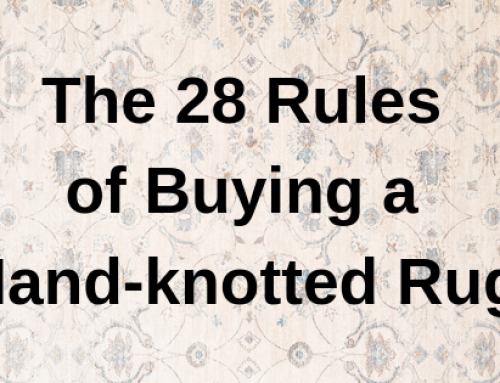The texture of a carpet depends on the technique used for weaving. Usually, handmade carpets are expensive because of the artistry, time and effort utilized in making them.
Hand-knotted rugs are among the most prized and expensive rugs all around the world. They have been preferred by the consumers to depict their classy taste and love for art. They employ expert craftsmen, who put in their craftsmanship for hours, day in and day out to produce a product that is cherished for generations. Hand-knotted rugs have typically complex designs and fine details. Since they take up too much time and expertise, the producers make sure to use the best weaving material, which is wool and that too from young sheep.
These rugs are timeless and age beautifully. They increase in value over time and add beauty to their surroundings. Their maintenance and cleaning is easier as compared to the synthetic rugs. The durability and resilience are matchless.
Characteristics of Hand-knotted rugs
These rugs are formed by millions of knots tied individually onto a foundation. After the knotting is finished, the rug is shaved to the desired pile size. These rugs have a distinct front and back side. The front side has the plush look with a soft touch, whereas the back holds the knotted surface. Iran, Pakistan, China, India, Afghanistan, Turkey, Romania, and Russian states are known for producing the best quality hand-knotted rugs.
The quality of the wool used is the basic factor that lays the foundation for a superior quality rug. The workmanship involved along with the design and the numbers of knots are the elements which together make a masterpiece to be cherished. The density of the wool and the ply of the yarn made from the wool differ according to the different types of the hand-knotted rugs.
The two main categories of hand-knotted rugs are:
Flat–woven Rugs
This weaving does not involve knots or any foundation. Flat-woven rugs have patterns weaved by horizontal and vertical threads. The warp strands serve as the base and the weft strands are interweaved through. This simple cross weaving makes these rugs reversible. These rugs are used on both sides which add to their longevity. Following are a few types of flat weaved rugs:
- Dhurry is a casual flat-weave rug commonly made of cotton yarn. They have always been in demand and last for years because of their durability and the reason that they can be used on both sides.
- Soumak is the plush type with a soft feel. The thick weaves are formed by passing wefts over double strands of warps, or sometimes even four strands of warps and then again down under the multiple warps. This weaving technique creates a herringbone texture on the top side of the rug and gives it the supple plush texture.
- Kilim is one of the oldest rug type known in the flat-weave category. The design is created by the weft strands, which also make the main color of the rug. The wefts strands are looped through the warp strands to form the pattern and make the color transitions in the design.
The Piled Rugs
The pile rugs have a mesh sort of foundation on which special knots of the wool yarn are wrapped around to form the pattern. The thick pile of yarn knotted together makes the plush surface that these rugs are famous for. The piled rugs have several different types of weaves listed below:
- Persian weave rugs are the most common type available in pile rugs. These rugs vary in thickness which is a major factor on which the price of piled rugs depends. The intricate patterns of Persian piled rugs usually make use of contrasting colors knotted together in succession. The designs available are named after famous cities of Iran, from where they originated.
- Sculptured weave rugs are the thickest pile rugs known for their simpler designs and bulky knotted weave. The patterns are formed at the junction of contrasting colors used in the weaving.
- Nepal weave is a rather modern type of weaving in piled rugs. The patterns are subtle, mostly abstract or inspired by nature.
Types of Knots in Hand-knotted Rugs
There are two basic types of knots which are preferred by the craftsmen for hand-knotted rugs. The Senneh knot and the Ghiordes knot are used in good quality handmade rugs. The third type known as the Jufti knot is also used but not preferred. It is considered inferior and this technique is not used in supreme quality rugs.
Senneh Knot
Senneh knot is also known as Persian knot as they are widely employed in different regions in:
- Iran
- Pakistan
- Afghanistan
- India
- Central Asia.
They are also known as double knots. This knot is also known as a double knot. Persian knots are asymmetrical in their formation. These asymmetrical knots are used for the rugs with very fine details.
Ghiordes Knot
This is the single knot type and is symmetrical in its pattern. This knot type is particularly preferred by Turkish weavers in Anatolia and Caucasia. It is also popular among the Kurdish tribes in Iran. The symmetrical knots are employed to make secure and well-assembled piles.
Jufti Knot
This is a lesser popular knot. It is mostly used in Khorassan region in Iran. This knot is usually used in rugs common use and which are not very expensive. The knots are not very dense and take comparatively less time than the other knot types. This does not result in the fine weaving that is the epitome of fine handmade rugs. The rugs made of Jufti knots are not very strong and durable, that is why they are not rated among the superior quality rugs.
The common types of hand-knotted rugs are:
- Baluchi
- Chobi
- Beljik
- Heriz
- Gabbeh,
- Khan-Mamdiu
- Kazak
- Shairwan
- Qashqai
The Knots are mainly from Persian, Bokhara and Tribal rugs. These rugs are categorized on the basis of the region they originate from; the material used; the number of knots per square inch and intricate designs each type is famous for.


